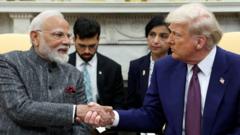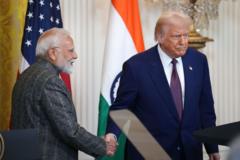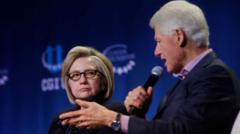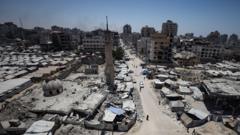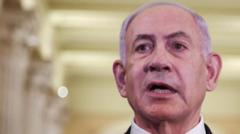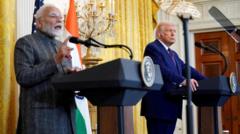**This article examines the ongoing conflict, highlighting the geopolitical implications and calls for renewed military support for Ukraine in light of intensified attacks.**
**Escalating Russian Attacks on Ukraine Amid Changed U.S. Administration Dynamics**
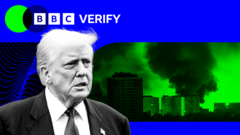
**Escalating Russian Attacks on Ukraine Amid Changed U.S. Administration Dynamics**
**Recent analysis reveals a dramatic increase in Russian drone and missile strikes against Ukraine since the start of Trump's second presidential term, raising urgent concerns over escalating military actions.**
In a startling turn of events, an analysis by BBC Verify indicates that since January, Russian forces have significantly escalated their aerial assaults on Ukraine, with over 27,000 drone and missile strikes recorded. This marks more than a twofold increase compared to the last months of the Biden administration. Despite former President Donald Trump’s campaign promises of a potential ceasefire, the data reveals that attacks surged sharply following his return to office.
During his campaign, Trump claimed that had he been in power, Russia’s invasion of Ukraine might have been avoided due to the Kremlin's respect for his leadership. Critics, however, have accused him of showing bias towards Russia as he navigates his administration's efforts for diplomatic resolution. There were reports of the suspension of military aid to Ukraine on two separate occasions, which coincided with Russia ramping up its military production, including a 66% increase in ballistic missile construction over the past year.
Since Trump assumed the presidency, attacks have reached unprecedented levels in this ongoing conflict, with figures showing 27,158 munitions launched between January 20 and July 19, compared to 11,614 during Biden’s last six months in office.
White House Deputy Press Secretary Anna Kelly has criticized Biden’s handling of the war, attributing its prolongation to what she described as incompetence, while stating that Trump seeks an end to the violence by fortifying U.S. military support to NATO allies and threatening Russia with tariffs for a ceasefire.
Initial talks aimed at limiting conflict seem to have had a transient effect on aggression levels, as discussions among U.S. diplomats and Russian counterparts have seen attacks resurge. Notably, the number of nightly explosions in the Ukrainian capital has made life increasingly precarious for civilians, triggering widespread anxiety.
Senator Chris Coons highlighted concerns that Trump's delayed military support may have emboldened Russian aggression, prompting calls for immediate resupply of Patriot anti-air systems to Ukraine. The urgency has grown as Russian forces are reported to be producing up to 170 drones per day, while missile manufacturing has also drastically increased.
Experts emphasize that the implications of Trump's military supply pauses have left Ukraine vulnerable, with defense analyst Justin Bronk asserting that insufficient military equipment from the U.S. has allowed Russia to intensify their assaults. Ukraine's military intelligence has revealed staggering figures of missile production and drone output, emphasizing the Russian commitment to sustained attacks against civilian infrastructure.
The conflict shows no signs of resolution, as the ongoing military engagements have drained public morale in Ukraine. Citizen journalists like Dasha Volk express the daily toll the war takes on civilians, with the chilling uncertainty of survival dictating their lives. The path to peace remains precarious as both sides navigate the turmoil of renewed hostilities and international relations, with increasing urgency for effective intervention in the ongoing crisis.
During his campaign, Trump claimed that had he been in power, Russia’s invasion of Ukraine might have been avoided due to the Kremlin's respect for his leadership. Critics, however, have accused him of showing bias towards Russia as he navigates his administration's efforts for diplomatic resolution. There were reports of the suspension of military aid to Ukraine on two separate occasions, which coincided with Russia ramping up its military production, including a 66% increase in ballistic missile construction over the past year.
Since Trump assumed the presidency, attacks have reached unprecedented levels in this ongoing conflict, with figures showing 27,158 munitions launched between January 20 and July 19, compared to 11,614 during Biden’s last six months in office.
White House Deputy Press Secretary Anna Kelly has criticized Biden’s handling of the war, attributing its prolongation to what she described as incompetence, while stating that Trump seeks an end to the violence by fortifying U.S. military support to NATO allies and threatening Russia with tariffs for a ceasefire.
Initial talks aimed at limiting conflict seem to have had a transient effect on aggression levels, as discussions among U.S. diplomats and Russian counterparts have seen attacks resurge. Notably, the number of nightly explosions in the Ukrainian capital has made life increasingly precarious for civilians, triggering widespread anxiety.
Senator Chris Coons highlighted concerns that Trump's delayed military support may have emboldened Russian aggression, prompting calls for immediate resupply of Patriot anti-air systems to Ukraine. The urgency has grown as Russian forces are reported to be producing up to 170 drones per day, while missile manufacturing has also drastically increased.
Experts emphasize that the implications of Trump's military supply pauses have left Ukraine vulnerable, with defense analyst Justin Bronk asserting that insufficient military equipment from the U.S. has allowed Russia to intensify their assaults. Ukraine's military intelligence has revealed staggering figures of missile production and drone output, emphasizing the Russian commitment to sustained attacks against civilian infrastructure.
The conflict shows no signs of resolution, as the ongoing military engagements have drained public morale in Ukraine. Citizen journalists like Dasha Volk express the daily toll the war takes on civilians, with the chilling uncertainty of survival dictating their lives. The path to peace remains precarious as both sides navigate the turmoil of renewed hostilities and international relations, with increasing urgency for effective intervention in the ongoing crisis.


